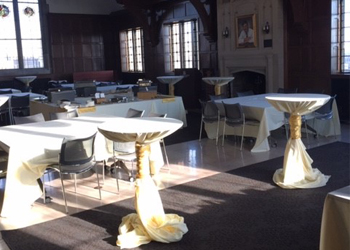Food and Beverage Planning Tips
Food & Beverage Planning Tips
Food
- For every plated meal, allow for at least one wait staff for every 25 guests at breakfast and one for every 20 at lunch and dinner. For buffet, allow one wait staff for every 40 guests at breakfast and one for every 30 at lunch and dinner.
- For receptions with no meal, plan on 14 appetizers per person per hour. Over the lunch hour, 10 appetizers per person are appropriate. For late afternoon or late evening receptions 6 - 8 appetizers is sufficient.
Beverages
- Have one bar and bartender for every 75 guests at a hosted bar, and one for every 100 guests at a cash bar.
- Spread out the bars to help keep lines manageable. Don't put them too close to food stations or seating areas.
Additional Considerations
- Use cultural cuisine. Ethnic-inspired receptions offer a wonderful opportunity to serve inexpensive foods, such as beans and rice, pasta, tacos and wraps.
- Substitute menu items. Serve chicken piccata instead of veal piccata, for example, may save a significant amount of money.
- Change the cut, If you'd like to serve fillet mignon but don't have the budget, ask the chef to recommend a less expensive cut of beef.
- Eliminate courses. Serve a salad instead of soup and salad.
- Purchase nonperishable items, such as cereals and granola bars that can be billed on consumption.
- Served passed hors d-oeuvres. Your labor costs are higher, but this should be offset by lower food costs. Guest tend to eat less when the food is passed versus buffet style.
- When serving passed foods, place only one type of food on each tray. This speeds up the serving process and reduces food consumption.
- Position buffet tables along a wall. Consumption drops when people don't have 360 degree access to food tables.
- Determine if it's less expensive to purchase hors d-oeuvres by the piece or by the person. If you order per person, find out how many pieces per person the price includes.
- Order enough food, but not too much! Use this rule of thumb: one ounce of dry snacks per person, enough anchor foods (such as cheese and vegetables) for one-third of the attendees, enough food at action stations for half of the attendees, one hot hors d-oeuvres of each type for each person, and enough desert and coffee for one-third to one-half of attendees. These estimates are made on the assumption that the reception will replace dinner.
- Ensure that hors d-oeuvres are bite-sized. This will make the foods easier to consume and reduce waste.
- Keep seating to a minimum. The availability of tables and chairs encourages people to sit and eat rather than network. Chairs for 25 - 30 percent of reception attendees is optimal.
Beverage Planning Charts
Morning Break Beverages
| DRINKS |
ALL MALE |
ALL FEMALE |
50/50 |
| Regular Coffee |
Attendance x 60% |
Attendance by 50% |
Attendance by 55% |
| Decaf Coffee |
Attendance x 20% |
Attendance by 25% |
Attendance by 25% |
| Tea |
Attendance x 10% |
Attendance by 15% |
Attendance by 10% |
| Soda |
Attendance by 25% |
Attendance by 25% |
Attendance by 25% |
Afternoon Break Beverages
| DRINKS |
ALL MALE |
ALL FEMALE |
50/50 |
| Regular Coffee |
Attendance by 35% |
Attendance by 30% |
Attendance by 35% |
| Decaf Coffee |
Attendance by 20% |
Attendance by 20% |
Attendance by 20% |
| Tea |
Attendance by 10% |
Attendance by 15% |
Attendance by 10% |
| Soda |
Attendance by 70% |
Attendance by 70% |
Attendance by 70% |
How to use these charts: Locate the percentage of the make of your group and multiply that percentage by your overall attendance. Then divide the resulting number by 20 (size-ounce cups per gallon) to determine the number of gallons needed. Round each partial gallon up to the next gallon. For example, for a morning break at a conference that has an audience of 500 predominately male attendees, the formula should be calculated as follows:
Regular Coffee = 500 x 60% = 300 cups / 20 = 15 gallons
Decaf Coffee = 500 x 20% = 100 cups / 20 = 5 gallons
Tea = 500 x 10% = 50 cups / 20 = 2.5 gallons
Soda = 500 x 25% = 125 canned beverages
